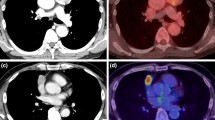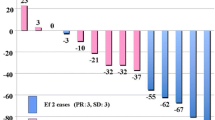Abstract
Introduction
18Fluorine-fluorodeoxyglucose positron emission tomography/computed tomography is not yet accepted as a standard pretreatment evaluation of thymic epithelial neoplasm (TEN). Statistical correlation between standardized uptake value of tumor/mediastinum ratio and patients’ WHO risk class has been reported. PET metabolic tumor volume (MTV) and total glycolytic volume (TGV) have been reported as additional prognostic imaging biomarkers in several human tumors. Purpose of study was to establish whether MTV and TGV add prognostic information in TEN.
Materials and methods
A retrospective dynamic cohort study of prospectively collected data (2006–2012) on 23 consecutive patients with pathologically proven TEN (no thymic carcinoma) was conducted. All patients underwent chest CT, and PET for staging. SUV T/M ratio, semi-quantitative and volumetric analyses of TEN were calculated. Patients were categorized according to WHO classification (low-risk and high-risk thymomas). Statistical analysis was performed with bootstrap method. Multi-collinearity was established using Pearson correlation coefficient. Cut-off point for TGV was compared using Mantel Cox log rank test.
Results
SUV T/M ratio, MTV, and TGV correlate with low- and high-risk TEN. However, the statistical correlation between TGV and WHO classification (ρ = 0.897) was higher than SUV T/M ratio (ρ = 0.873). Since sample distributions were not uniformly smooth, only one cut-off value was identified: a TGV of 383 served as a cut-off value between low-risk and high-risk TEN.
Conclusion
TGV is a PET reproducible imaging marker in patients with TEN, provides prognostic information, and could be useful in pretreatment stratification of patients. Nevertheless, it needs validation in larger cohort studies.



Similar content being viewed by others
References
Benveniste MF, Moran CA, Mawlawi O, Fox PS, Swisher SG, Munden RF, et al. FDG PET-CT aids in the preoperative assessment of patients with newly diagnosed thymic epithelial malignancies. J Thorac Oncol. 2013;8:502–10.
Thomas A, Mena E, Kurdziel K, Venzon D, Khozin S, Berman AW, et al. 18F-fluorodeoxyglucose positron emission tomography in the management of patients with thymic epithelial tumors. Clin Cancer Res. 2013;19:1487–93.
Terzi A, Bertolaccini L, Rizzardi G, Luzzi L, Bianchi A, Campione A, et al. Usefulness of 18-F FDG PET/CT in the pre-treatment evaluation of thymic epithelial neoplasms. Lung Cancer. 2011;74:239–43.
Soret M, Bacharach SL, Buvat I. Partial-volume effect in PET tumor imaging. J Nucl Med. 2007;48:932–45.
Vanderhoek M, Perlman SB, Jeraj R. Impact of the definition of peak standardized uptake value on quantification of treatment response. J Nucl Med. 2012;53:4–11.
Larson SM, Erdi Y, Akhurst T, Mazumdar M, Macapinlac HA, Finn RD, et al. Tumor treatment response based on visual and quantitative changes in global tumor glycolysis using PET-FDG Imaging. The visual response score and the change in total lesion glycolysis. Clin Positron Imaging. 1999;2:159–71.
Moon SH, Choi JY, Lee HJ, Son YI, Baek CH, Ahn YC, et al. Prognostic value of 18F-FDG PET/CT in patients with squamous cell carcinoma of the tonsil: comparisons of volume-based metabolic parameters. Head Neck. 2013;35:15–22.
Moon SH, Hyun SH, Choi JY. Prognostic significance of volume-based PET parameters in cancer patients. Korean J Radiol. 2013;14:1–12.
Travis WD, Brambilla E, Müller-Hermelink HK, Harris CC. Pathology and genetics of tumours of the lung, thymus and heart. Lyon: IARC Press; 2004.
Koga K, Matsuno Y, Noguchi M, Mukai K, Asamura H, Goya T, et al. A review of 79 thymomas: modification of staging system and reappraisal of conventional division into invasive and non-invasive thymoma. Pathol Int. 1994;44:359–67.
Detterbeck F, Nicholson A, Kondo K, Van Schil P, Moran CA. The Masaoka-Koga stage classification for thymic malignancies: clarification and definition of terms. J Thorac Oncol. 2011;6:S1710–6.
Ciernik IF, Dizendorf E, Baumert BG, Reiner B, Burger C, Davis JB, et al. Radiation treatment planning with an integrated positron emission and computer tomography (PET/CT): a feasibility study. Int J Radiat Oncol Biol Phys. 2003;57:853–63.
Cohen J. Statistical power analysis for the behavioral sciences. 2nd ed. Hillsdale: Erlbaum; 1988.
Anderson TW. An introduction to multivariate statistical analysis. New York: Wiley; 1958. p. 126–31.
Liu RS, Yeh SH, Huang MH, Wang LS, Chu LS, Chang CP, et al. Use of fluorine-18 fluorodeoxyglucose positron emission tomography in the detection of thymoma: a preliminary report. Eur J Nucl Med. 1995;22:1402–7.
Sung YM, Lee KS, Kim BT, Choi JY, Shim YM, Yi CA. 18F-FDG PET/CT of thymic epithelial tumors: usefulness for distinguishing and staging tumor subgroups. J Nucl Med. 2006;47:1628–34.
Kaira K, Murakami H, Miura S, Kaira R, Akamatsu H, Kimura M, et al. 18F-FDG uptake on PET helps predict outcome and response after treatment in unresectable thymic epithelial tumors. Ann Nucl Med. 2011;25:247–53.
Ferdinand B, Gupta P, Kramer EL. Spectrum of thymic uptake at 18F-FDG PET. Radiographics. 2004;24:1611–6.
El-Bawab H, Al-Sugair AA, Rafay M, Hajjar W, Mahdy M, Al-Kattan K. Role of flourine-18 fluorodeoxyglucose positron emission tomography in thymic pathology. Eur J Cardiothorac Surg. 2007;31:731–6.
Wahl RL, Jacene H, Kasamon Y, Lodge MA. From RECIST to PERCIST: evolving considerations for PET response criteria in solid tumors. J Nucl Med. 2009;50:122S–50S.
Prasad SR, Jhaveri KS, Saini S, Hahn PF, Halpern EF, Sumner JE. CT tumor measurement for therapeutic response assessment: comparison of unidimensional, bidimensional, and volumetric techniques—initial observations. Radiology. 2002;225:416–9.
Haie-Meder C, Pötter R, Van Limbergen E, Briot E, De Brabandere M, Dimopoulos J, et al. Recommendations from gynaecological (GYN) GEC-ESTRO working group (I): concepts and terms in 3D image based 3D treatment planning in cervix cancer brachytherapy with emphasis on MRI assessment of GTV and CTV. Radiother Oncol. 2005;74:235–45.
Shibata H, Nomori H, Uno K, Sakaguchi K, Nakashima R, Iyama K, Tomiyoshi K, Kaji M, Goya T, Suzuki T, Horio H. 18F-fluorodeoxyglucose and 11C-acetate positron emission tomography are useful modalities for diagnosing the histologic type of thymoma. Cancer. 2009;115:2531–8.
Miederer M, Seidl S, Buck A, Scheidhauer K, Wester HJ, Schwaiger M, Perren A. Correlation of immunohistopathological expression of somatostatin receptor 2 with standardised uptake values in 68Ga-DOTATOC PET/CT. Eur J Nucl Med Mol Imaging. 2009;36:48–52.
Conflict of interest
All the authors have no conflict of interest.
Author information
Authors and Affiliations
Corresponding author
Rights and permissions
About this article
Cite this article
Bertolaccini, L., Viti, A., Lanzi, E. et al. 18Fluorine-fluorodeoxyglucose positron emission tomography/computed tomography total glycolytic volume in thymic epithelial neoplasms evaluation: a reproducible image biomarker. Gen Thorac Cardiovasc Surg 62, 228–233 (2014). https://doi.org/10.1007/s11748-014-0374-1
Received:
Accepted:
Published:
Issue Date:
DOI: https://doi.org/10.1007/s11748-014-0374-1




